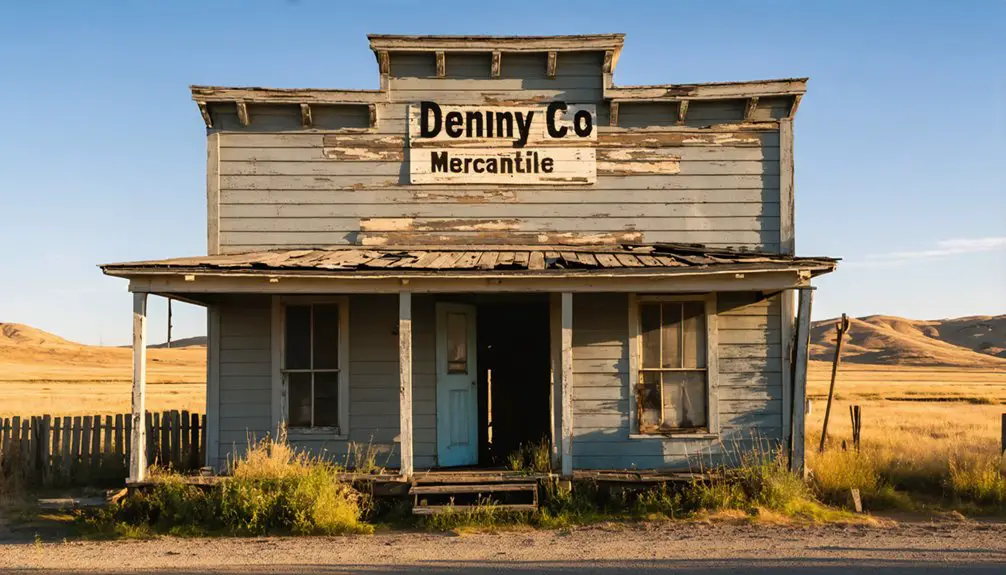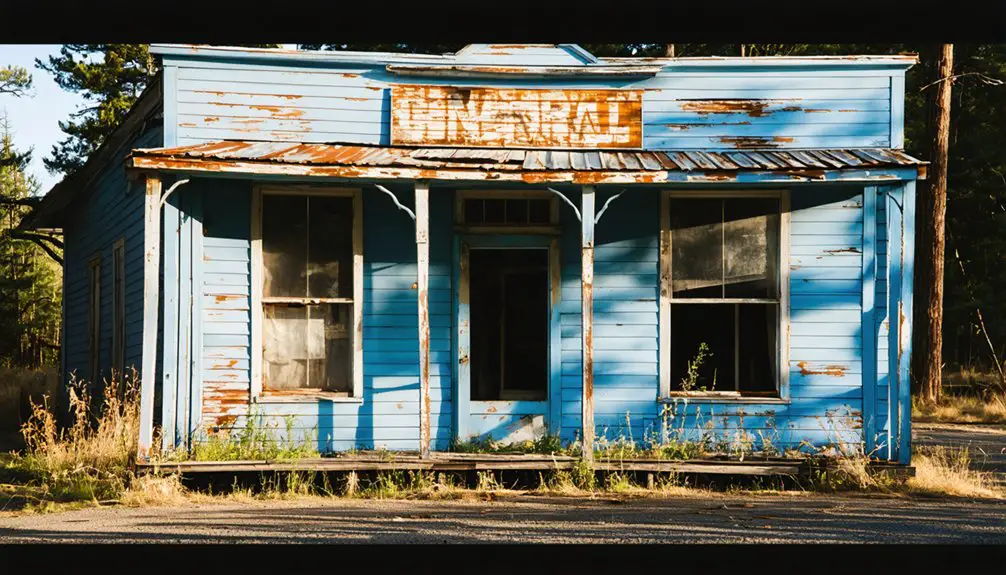You’ll find Bolster’s ghost town remains along Meyers Creek in Okanogan County, Washington, two miles north of Chesaw near the Canadian border. Founded in 1899 by J.S. McBride and named after Herman Bolster, this mining boomtown once boasted three saloons, multiple stores, and a three-story hotel among its 90 log buildings. Though its post office closed in 1909, scattered foundations and rusted mining equipment still tell tales of this frontier settlement’s brief but vibrant past.
Key Takeaways
- Bolster was established in 1899 near Chesaw, Washington, as a mining town with three saloons, multiple stores, and about 90 log buildings.
- The town’s business district featured a prominent three-story hotel and served as a commercial hub for the local mining community.
- Bolster’s economy relied heavily on unstable mining activities, which ultimately contributed to its eventual abandonment and ghost town status.
- The closure of the post office in 1909 marked a significant decline, leading to business closures and residents leaving the area.
- Today, only scattered foundations and deteriorated equipment remain among dense forest growth, marking the former mining town’s location.
The Birth of a Frontier Settlement
When the U.S. government opened the area to mineral entry in 1896, prospectors and entrepreneurs quickly recognized the region’s potential.
The 1896 opening of mineral rights sparked immediate interest as prospectors and businessmen saw opportunities in the untapped region.
You’ll find that J.S. McBride seized this opportunity, plotting the town in 1899 and naming it after Herman Bolster, a Spokane financier whose name they hoped would attract investment to overcome frontier challenges.
As mining prospects drew settlers to this remote corner of Okanogan County, you’d have seen a bustling community emerge along Meyers Creek, just two miles north of Chesaw near the Canadian border.
Like the traditional Middle English origins of its namesake, the town of Bolster represented a foundation of support for the growing mining community.
The name Bolster followed the pattern of Anglo-Saxon surnames that were common in frontier towns of the era.
The settlement soon boasted three saloons, multiple stores, and a newspaper called The Bolster Drill.
Within a few years, about thirty families called Bolster home, creating an essential hub for both American and Canadian mining operations.
A Tale of Two Border Towns
You’ll find the relationship between Bolster and Chesaw unique among frontier settlements, as they recognized each other as suburbs despite being separate towns.
Their close proximity, just 2 miles apart near the Canadian border, created natural opportunities for trade and social exchange among the approximately 30 families in Bolster.
The towns’ mutual support through local commerce, including supplies from Bolster’s stores and saloons, helped both communities maintain economic activity in early Okanogan County. Local households often used long narrow pillows called bolsters for sleeping comfort, following a tradition dating back to Old English times. Like the historic town of Lester, Bolster experienced a decline when technological advances transformed the region’s economic landscape.
Cross-Border Trade Relations
Located just two miles apart, Bolster and Chesaw developed such close economic and social ties in the early 1900s that residents affectionately referred to each other’s communities as “suburbs.”
This unique relationship fostered a vibrant cross-border trade network, with both towns maintaining essential services like post offices, stores, and saloons that supported roughly thirty families in Bolster alone.
The towns’ economic partnerships extended beyond basic commerce, creating a diverse marketplace where you’d find retail shops and hospitality services thriving together.
Their strategic position near the Canadian border opened additional opportunities for cross border commerce, though success remained tied to regional infrastructure and evolving customs policies.
This interdependence lasted until 1909, when Bolster’s post office closure signaled the beginning of a decline in formal trade relations.
Local Rivalry Benefits Growth
The rivalry benefits manifested in several key ways:
- Infrastructure development through competing postal services and schools
- Economic growth spurred by multiple saloons, stores, and local commerce
- Cultural enrichment through newspaper publishing and social activities
- Enhanced market options and trade opportunities for residents
Much like the thriving mining operations in gold rush times that drew 1,500 prospectors to the region, the period of active rivalry helped establish essential services and social connections that sustained both communities during their peak years.
Daily Life in Early Bolster
Living in early Bolster, you’d find social life centered around the town’s three saloons, where neighbors gathered to unwind after long days of work and trade.
Your daily routines would’ve revolved around shopping at local stores for essentials, though you’d likely have grown much of your own food given the remote location.
You’d have spent evenings socializing with other families from both Bolster and neighboring Chesaw, creating a close-knit community atmosphere despite the town’s small size.
Social Activities and Entertainment
Life in early Bolster centered around a close-knit community of roughly 30 families who created their own brand of entertainment despite limited formal venues.
You’d find most community gatherings taking place in the town’s three saloons, where informal exchanges, card games, and lively conversations filled the evenings. Like the town of Liberty in 1873, residents were drawn together by the promise of gold mining opportunities.
The social fabric extended beyond Bolster’s boundaries, with residents regularly trading and socializing with neighboring Chesaw, forming an interconnected frontier network.
- The local post office served as a natural meeting spot until 1909
- Brief-lived enterprises like The Bolster Drill newspaper and a school in 1910 offered additional social outlets
- Outdoor activities tied to mining life provided recreational opportunities
- Cross-town relationships with Chesaw created an extended social circle
Food and Household Routines
Daily sustenance in early Bolster revolved around five essential food sources: local trade, home gardens, wild game, general store supplies, and preserved goods.
You’d find families tending their vegetable patches while trading with nearby Chesaw for additional provisions. Local ingredients made their way into cast iron skillets and Dutch ovens atop wood-fired stoves, where daily routines centered around preparing family meals from scratch. Like patients at Northern State Hospital, residents engaged in occupational therapy through gardening and food preparation.
Women managed household chores using basic kitchen tools, while children helped fetch water and tend to animals. Similar to Lester’s residents, families relied heavily on school gatherings for social activities and community meals.
Food preservation became vital as seasons changed, with smoking, drying, and salting ensuring winter survival. Community sharing strengthened bonds, especially during harvest time.
Cooking methods adapted to available resources, whether you’re baking bread in wood-fired ovens or brewing coffee from store-bought beans.
The Business District’s Rise and Fall
When Bolster’s business district first emerged in 1899, it quickly established itself as a small but vibrant commercial hub serving the region’s mining boom community.
You’d find three stores and multiple saloons catering to the thirty families who called Bolster home, with The Bolster Drill newspaper keeping everyone informed of local happenings. A prominent three-story hotel stood among the roughly 90 log buildings that made up the town. Similar to the mining office still visible in Nighthawk today, Bolster maintained its own administrative center for local mining operations.
Here’s what led to the district’s ultimate downfall:
Several key factors led to Bolster’s collapse, marking a steady decline that transformed a once-bustling mining town into history.
- Heavy dependence on volatile mining activity without business sustainability planning
- Limited diversification beyond mining-related commerce
- Fierce competition with neighboring Chesaw for the same customer base
- Loss of essential services like the post office by 1909
The business district’s fate was sealed as mining activity declined, causing stores to shutter and residents to seek opportunities elsewhere, ultimately transforming Bolster into a ghost town.
Education and Postal Services

You’ll find Bolster’s educational footprint was remarkably brief, with its only school operating for just a single year in 1910 to serve about thirty families.
The town’s post office, established during Bolster’s 1899 platting, closed its doors in 1909 after a decade of service.
These closures marked significant turning points in Bolster’s decline, with the post office’s shutdown predating the school’s short-lived attempt to serve the dwindling community.
Limited School Operations
Despite Bolster’s modest size of thirty families, the town maintained a school for a brief period in 1910, operating alongside the recently closed post office.
The school’s short existence reflected the town’s limited educational resources and challenges in sustaining community infrastructure during a period of economic uncertainty.
- You’ll find the school represented a final attempt to establish permanent services in Bolster, following the post office’s closure in 1909.
- The town’s education system focused on basic primary schooling for local children.
- You can trace the school’s brief operation to broader patterns of temporary educational services in Washington’s ghost towns.
- The limited duration mirrors similar situations in other mining communities where population fluctuations affected public services.
Post Office Final Years
Throughout Bolster’s brief existence, the post office served as a vital communication hub for approximately thirty families until its closure in 1909, marking a significant turning point in the town’s decline.
The postal service history of Bolster reflects the common fate of many rural settlements in early 20th century Washington, where post office closures often signaled the beginning of ghost town status.
The communication impact of losing postal services forced residents to rely on neighboring towns for mail delivery. This loss of federal presence coincided with other setbacks, including the newspaper’s closure and limited school operations in 1910.
You’ll find that Bolster’s post office, like many others, fell victim to improved transportation networks that centralized mail services in larger hubs, ultimately contributing to the town’s isolation and eventual abandonment.
Saloons and Social Life
At its peak, Bolster boasted three bustling saloons that formed the backbone of the town’s social scene, serving as crucial community hubs for the roughly thirty families who called it home.
Beyond typical saloon gatherings, these establishments were significant spaces where residents traded news, conducted business, and maintained community connections.
You’d find the social fabric of Bolster woven through its stores, post office, and brief school presence, with nearby Chesaw considered a sister community.
- Trade deals and business partnerships often emerged from casual conversations at saloon tables
- News spread quickly through informal networks at these gathering spots
- Community events naturally gravitated toward these established social centers
- Relationships with neighboring towns strengthened through shared social spaces
Notable Figures and Founding Families

While Bolster’s history spans just over a decade, two key figures shaped its establishment in 1899: J.S. McBride, who platted and sold the town’s lots, and Herman Bolster, the Spokane financier whose name graces the settlement. McBride’s vision positioned the town as a commercial hub supporting the region’s burgeoning mining interests.
During its peak years, you’d have found about thirty founding families calling Bolster home. These early settlers established essential services, including a post office, school, and the local newspaper “The Bolster Drill.”
The community maintained close ties with nearby Chesaw, with residents of both towns considering each other suburbs. Though individual family names haven’t survived in historical records, these pioneering settlers created a brief but vibrant community centered around mining, commerce, and frontier life.
Economic Challenges and Decline
Despite its promising start during the 1899 mining boom, Bolster’s economy proved unsustainably dependent on mineral extraction. The town’s mining reliance became its downfall as ore yields diminished and economic stagnation set in.
You’ll find that Bolster’s initial prosperity – with three stores, three saloons, and a post office serving thirty families – quickly evaporated when mining prospects faded.
- The post office’s closure in 1909 marked the beginning of essential services vanishing
- A single year of schooling in 1910 reflected the exodus of families
- The local newspaper’s failure highlighted shrinking commercial opportunities
- Competition from railway-connected towns like Brewster hastened Bolster’s decline
Without diversification beyond mining or investment in infrastructure, Bolster couldn’t sustain itself, ultimately becoming another Washington ghost town by the 1910s.
What Remains Today

Today’s visitors to Bolster will find little evidence of the once-bustling mining town, as nature has steadily reclaimed the site over the past century.
You’ll need to look carefully to spot the ghost town remnants – only scattered foundations and deteriorated equipment pieces remain visible among the dense forest growth that now dominates the landscape.
If you’re planning to explore, be aware that there’s no formal access or maintained trails to guide your way.
The site lacks protective barriers or interpretive signs, and you’ll need to navigate carefully around unstable ground and overgrown vegetation.
While you might discover fragments of mining tools or household items partially exposed in the soil, nature’s reclamation has transformed Bolster into a remote wilderness where wildlife now thrives undisturbed.
Exploring the Historic Site
If you’re interested in exploring Bolster’s historic site, you’ll find it roughly two miles north of Chesaw near Meyers Creek in Okanogan County.
As you venture into this ghost town exploration, you’ll be walking through a significant piece of Washington’s mining heritage that dates back to the 1896 mineral rush.
- Position yourself near Meyers Creek to understand why early settlers chose this location for mining operations.
- Look for remnants of the three saloons and various stores that once served thirty families.
- Search the area where the post office operated until 1909.
- Compare the site’s location to nearby ghost towns to appreciate the region’s interconnected mining communities.
The site’s proximity to the Canadian border and its relationship with Chesaw offers unique insights into frontier life.
Frequently Asked Questions
Were There Any Major Crimes or Shootouts in Bolster’s Saloons?
You won’t find any documented saloon violence or notable crime history in Bolster’s drinking establishments. Historical records, newspapers, and local accounts don’t mention any major shootouts or criminal incidents there.
Did Indigenous Peoples Have Settlements or Trading Posts Near Bolster?
Plentiful peoples populated places near present-day Bolster. You’ll find Indigenous settlements dotted along waterways and trading routes, with local tribes like the Cowlitz and Chehalis maintaining seasonal camps and commerce networks.
What Happened to the Original Buildings and Their Materials?
You’ll find most original architecture was either salvaged for reuse, dismantled for materials, or left to decay naturally. Without historical preservation efforts, weather and time turned buildings into scattered rubble and foundations.
Was Gold or Silver Mining Ever Attempted Around Bolster?
Like gold fever spreading through veins of quartz, you’d find extensive mining around Bolster, where gold discoveries sparked a rush in 1896, and prospectors used both placer and hard-rock mining techniques.
Did Smuggling Occur Across the Nearby Canadian Border Through Bolster?
You won’t find evidence of smuggling routes through Bolster in historical records. While border patrol wasn’t established there yet, smugglers preferred using coastal ports and major transport hubs instead.
References
- https://brainly.infogalactic.com/info/Bolster
- https://en.wikipedia.org/wiki/Bolster
- https://washingtonstate.fandom.com/wiki/Bolster
- http://www.ghosttownsusa.com/okanco.htm
- https://www.wta.org/go-hiking/hikes/lester-ghost-town
- https://en.wikipedia.org/wiki/Lester
- http://www.ghosttownsusa.com/bolster.htm
- https://okanogancountry.com/ghost-towns
- https://en.wikipedia.org/wiki/List_of_ghost_towns_in_Washington
- https://www.pinterest.com/pin/219057969368838144/



